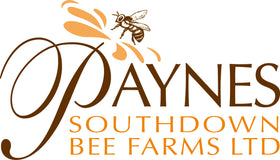About Our Heather Honey
The Journey of the Bees to the New Forest
See how millions of bees are moved to the heathland to gather the most iconic of British Honeys.....
The Big Migration
Every year, in July, hundreds of hives are moved from their usual apiary sites to the outer reaches of heathland. A large operation which involves carefully selecting only the biggest and best colonies from all the livestock, lugging them onto trailers and trucks and moving them early morning to their new locations. All this in search of Heather Honey
It's early morning, before the sun has even started to rise and we are already out in the apiary (the proper name for a group of beehives). We close the entrances to the hives to keep the bees inside while they are travelling. Each hive has been selected before hand to make sure each colony is strong and healthy and ready to work! They really will be busy as bees soon enough.
We load the hives onto the truck, strapping each one down to ensure they will be safe and sound, and we set off on the journey. It takes around 2 hrs to reach our destination and even by the time we get there, the sun is barely up.
We park up, and start the unloading of the hives. We position them nice and close to the heather making it as easy as possible for the bees to forage the flowers once they open. We want to make it as easy for them as possible, as autumn approaches it gets colder and wetter - not ideal weather for honey bees who will soon be preparing themselves for winter. Once sited, we strap them down again to prevent them blowing over or being knocked over by the ponies, donkeys and other livestock that roam the heathland. Then we wait, we wait for good weather and for the bees to work their magic...............
We load the hives onto the truck, strapping each one down to ensure they will be safe and sound, and we set off on the journey. It takes around 2 hrs to reach our destination and even by the time we get there, the sun is barely up.
We park up, and start the unloading of the hives. We position them nice and close to the heather making it as easy as possible for the bees to forage the flowers once they open. We want to make it as easy for them as possible, as autumn approaches it gets colder and wetter - not ideal weather for honey bees who will soon be preparing themselves for winter. Once sited, we strap them down again to prevent them blowing over or being knocked over by the ponies, donkeys and other livestock that roam the heathland. Then we wait, we wait for good weather and for the bees to work their magic...............

At the end of September, we return to the hives, hoping that the bees have had a good successful time. We don't know until we crack open the lids of the hives and peek down inside. We work with nature so know there are no guarantees with this, even the best laid plans rely on too much outside of our control.
We remove the honey boxes from the hives, hoping each one is a good weight (although it's not so good for our backs at the end of a long day) and sort out the honeycomb. Some will be cut out and sold as honeycomb, others will be 'crushed' and have the honey squeezed out of the honeycomb to be sold as jars of honey.
Later we'll repeat the travel arrangements for the bees, we close the entrances and load them up onto the truck to return back to Sussex where they will overwinter peacefully until the warm Spring temperatures starts them all off again.......
We remove the honey boxes from the hives, hoping each one is a good weight (although it's not so good for our backs at the end of a long day) and sort out the honeycomb. Some will be cut out and sold as honeycomb, others will be 'crushed' and have the honey squeezed out of the honeycomb to be sold as jars of honey.
Later we'll repeat the travel arrangements for the bees, we close the entrances and load them up onto the truck to return back to Sussex where they will overwinter peacefully until the warm Spring temperatures starts them all off again.......

Why Heather Honey
Honey from heather is an amazingly rich, strong flavoured honey. It has a jelly or gel like texture which means it doesn't 'run' out of the honeycomb like a normal, multifloral honey would. It has an exquisite, dark colouration.
How best to have it?
We always consider the best way to enjoy heather honey is as a honeycomb. The moment you crack open the white wax cappings with your spoon and dig into the fresh honey, releasing that iconic heather honey aroma.
Spread it on your toast and let it all melt, or serve with cheese and fresh figs.
Spread it on your toast and let it all melt, or serve with cheese and fresh figs.


